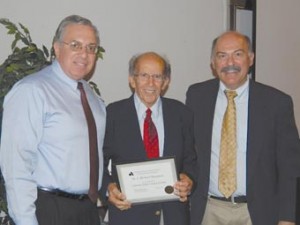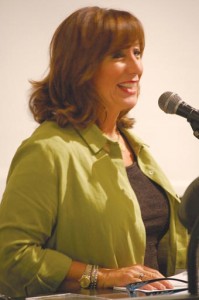Armen Melidonian
Staff Writer

Photo: Erica Magarian
On Friday, October 1, the Armenian Studies Program held a screening of Dr. J. Michael Hagopian’s The River Ran Red, a film devoted to the oral histories of Armenian Genocide survivors, many of whom are today no longer alive. After 95 years, without the documentation that Dr. Hagopian has conducted, many of the survivor accounts would have passed away. The memories can now be kept alive through film.
The River Ran Red is the third in a series of films, called Witnesses, produced and directed by Dr. Hagopian, that tell the story of the Armenian Genocide. The first two films in the series are Voices of the Lake and Germany and the Secret Genocide.
Armenian Studies Program Coordinator Prof. Barlow Der Mugrdechian was the master of ceremonies at the evening event, co-sponsored with the National Association for Armenian Studies and Research (NAASR). Former NAASR Board Chair Nancy Kolligian of Boston made a special trip to be present at the premiere Fresno screening and introduced Dr. Hagopian to the audience.
At the conclusion of the screening, Prof. Der Mugrdechian, on behalf of the Armenian Studies Program, presented Dr. Hagopian with a certificate honoring his “Lifetime Achievement in Film.”
Dr. Hagopian was a guest earlier in the day of the Fresno State Cineculture class and was a discussant after his film was screened. More than 100 students and community members were in attendance, and they eagerly engaged with the 96-year old Hagopian.
The river of the movie title refers to the Euphrates, along whose banks many Armenians perished. Dr. Hagopian has searched for Genocide survivors for over 40 years, recording and collecting the life stories of those who survived the deportation and eventually settled in communities around the Euphrates.
At the beginning of the World War I, an estimated two million Armenians lived in Ottoman Turkey, while at the conclusion of the war less than half a million survived. Dr. Hagopian’s search along the Euphrates led him first to Syria’s Der Zor desert, where the largest massacres of Armenians occurred. The Turkish government used the war as an excuse for carrying out the Genocide.

One of the witnesses to the massacres was Dr. Ernest Partridge, a Christian missionary in Turkey, who explained his role in helping a Turkish family hide Armenians. “The Turks would say they are taking them away from their families for their safety.” The separation of children from their parents created many orphans. In dealing with the orphans, the Turks realized that if they let them go, the children would remember what happened when they grew up. They would therefore drown as many of the orphans as they could in the Euphrates.
From minarets, Muslims announced that the Armenians should change their religion and some converted the next day. Harry Kurkjian recounted how he could sing well when he was a child. Turkish officers had him get circumcised, convert to Islam, and then forced him to learn Islamic call to prayers and songs.
One survivor testified that she had seen Turkish policemen bet on the sex of the baby of a seven month pregnant woman. They slit her open and settled the bet. After five hours, the child and mother were dead.
In Aleppo, Syria, 5,000 emaciated women and children arrived as deportees. Dr. Hagopian interviewed a number of Arabs who remembered when the Armenians arrived into the city. One Arab noted that “They came walking with their clothes torn.” They were going to be taken to Der Zor, which was used as an Ottoman Turkish concentration camp for Armenians. Dr. Hagopian’s film serves as an insightful source of testimonies that bring the deportations of Armenians and the role of the Euphrates River in the Genocide into fuller perspective. He is currently having the 400 videos of eyewitnesses he interviewed archived for the institutions he is working with.
 Hye Sharzhoom Armenian Action
Hye Sharzhoom Armenian Action